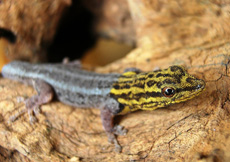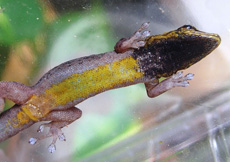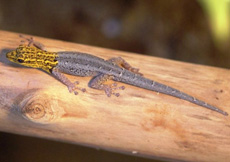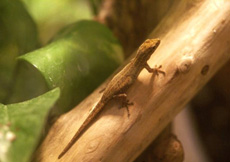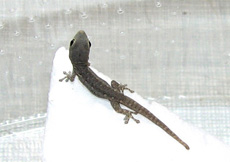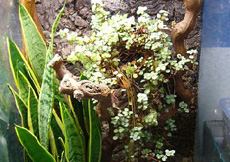Lygodactylus picturatus
(PETERS, 1868)
Distribution:
South-eastern Kenya, eastern Tanzania, Zanzibar and Mafia
Description:
As one of the greatest representatives of the genus, Lygodactylus picturatus reaches a maximum length of about 9 centimeters. Its tail accounts for about half of its size. Females are usually slightly smaller than males.
Like all members of the genus Lygodactylus they have sticky fins on the undersides of their toes, and on the underside of the tail. Males have a head and neck that is bright yellow, which is accompanied by a dark brown to black lined pattern. The remaining body is blue-gray and adorned with bright and dark ocellated spots. The abdomen has a yellow tinge, the throat is almost fully black. Males have 6-8 pre-anal pores between their legs.
The coloration of the females is less impressive than the males. The body is beige-brown with dark and light ocellated spots. The head may have a slight yellow coloration, but this is never so intense as in males. The belly in females is also yellow, the throat is white and marked with a pale gray marbling.
Habitat:
Lygodactylus picturatuss is an arboreal living gecko. It is found in forested coastal areas directly on the trunks of coconut trees, in thickets and in moist savannas on small trees and bushes. In addition Lygodactylus picturatus is synanthropic, they are also found on walls and fences. Since this species is very adaptable, even populations in thorny and dry savannas are known. In general, a composite consisting of a male and several females on a trunk, bush or tree. Young animals are tolerated in the group with the male, until juveniles reach sexual maturity.
Husbandry and Breeding:
A pair or trio consisting of one male and two females can be kept in a terrarium measuring 40x40x60 centimeters. The substrate should be a sand-soil mixture. The terrarium may be decorated with branches in varying thickness. Large leaved plants such as Sanseveria are also favored by Lygodactylus picturatus. A large piece of cork is used as a hideout and egg laying site.
Illumination for the terrarium can consist of a compact UVB bulb, a 20w halogen puck light and a daylight compact bulb. Temperatures range between 24-28°C (75-82°F) during the day, the temperatures below the basking area may safely reach 35°C (95°F). The humidity should be kept between 60-70%, which is easily achieved by a daily misting. The misting is also appreciated by the animals and happily licked of the leaves. Feeding is done 2-3 times per week alternating between crickets, firebrats, bean beetles and wax moths and their larvae. The food should always be dusted with the appropriate vitamins. Once a month the geckos may be offered fruit pulp. Peach & Passion fruit is especially popular with Lygodactylus picturatus.
The mating season begins between March and April. Males during this time display exceptional coloration to impress the females. After successful mating it is clearly possible to tell when the female is gravid. However the eggs will not be visible through the abdominal wall like with Phelsuma. After about 4 weeks of gestation, the female usually lays a double clutch. The eggs will happily be placed in small openings or in the gaps of cork. We have found that it is best to leave the eggs in the terrarium. The eggs hatch between 60-70 days. The juveniles measure 2.5 centimeters. The coloring corresponds to that of the female. Males will begin to show coloration at 3 to 4 months. The young are best raised separately in appropriate containers. The terrarium should be decorated like the parents, with a sand-soil mixture as the substrate, thin branches for climbing, small pieces of cork and small plants. Illumination may be provided with low-wattage T5 or compact tubes, since the containers would otherwise overheat. Every two days the hatchlings should be supplied with micro food, such as micro crickets, small fru it flies, small wax moth larvae or firebrats. Ideally, the ground floor should be seeded with springtails and woodlice. In young animals it is particularly important that the food is always dusted with the appropriate vitamins. They should also be supplied drinking water daily, which can be achieved by misting the enclosure once daily. The young sexually mature at about 10 to 12 months.
Lygodactylus picturatus is a very active, robust and inquisitive gecko, which makes them a lot of fun to keep. They are also easily cared for by well informed beginners. The raising of young animals can pose issues, due to their fragile nature, as with all members of the genus Lygodactylus. Wild caught animals are often a long time in transport and the animals from dealers are usually very weak and vulnerable. Unfortunately they are sold too cheap. I advise anyone who wants to keep Lygodactylus picturatus to only purchase animals which have been captive bred. Captive bred animals will allow one to enjoy the animals a lot more..
